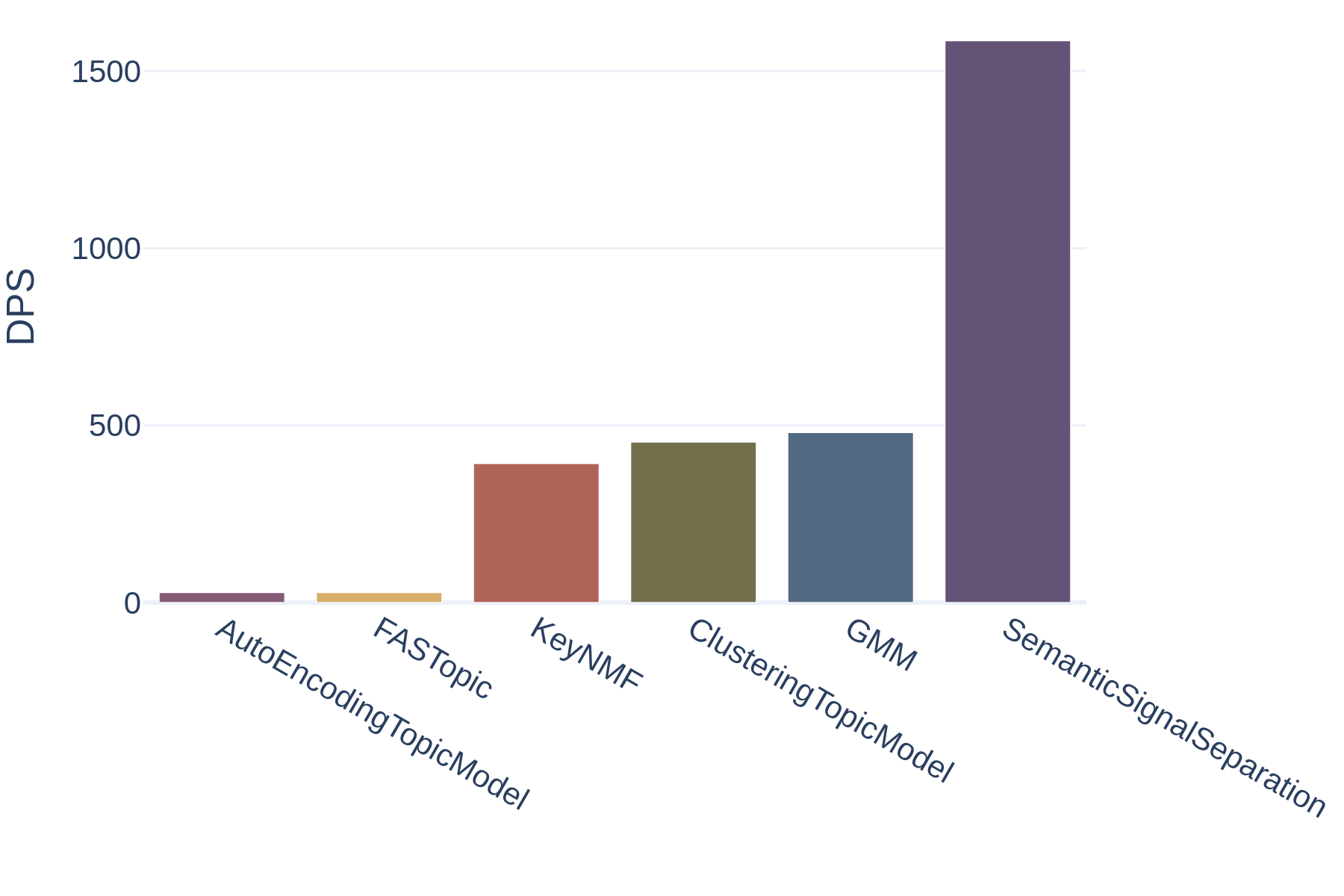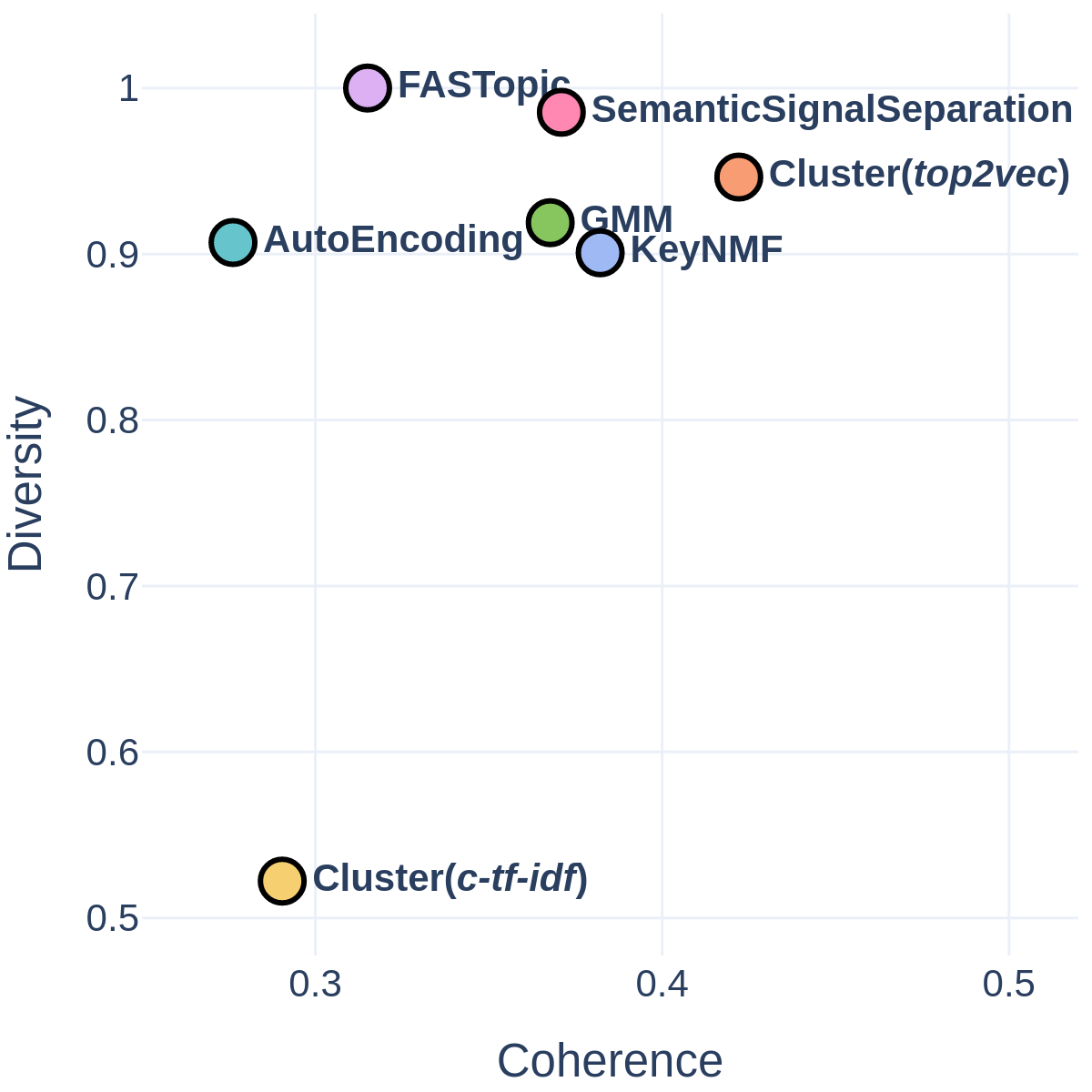Model Overview
Turftopic contains implementations of a number of contemporary topic models. Some of these models might be similar to each other in a lot of aspects, but they might be different in others. It is quite important that you choose the right topic model for your use case.
 Speed Speed |
 Long Documents Long Documents |
 Scalability Scalability |
 Flexibility Flexibility |
|---|---|---|---|
| SemanticSignalSeparation | KeyNMF | KeyNMF | ClusteringTopicModel |
Table 1: You should tailor your model choice to your needs

(Documents per Second; Higher is better)
Different models will naturally be good at different things, because they conceptualize topics differently for instance:
SemanticSignalSeparation(\(S^3\)) conceptualizes topics as semantic axes, along which topics are distributedClusteringTopicModelfinds clusters of documents and treats those as topicsKeyNMFconceptualizes topics as factors, or looked at it from a different angle, it finds clusters of words
You can find a detailed overview of how each of these models work in their respective tabs.
Some models are also capable of being used in a dynamic context, some can be fitted online, some can detect the number of topics for you and some can detect topic hierarchies. You can find an overview of these features in Table 2 below.

(Higher is better)
Warning
You should take the results presented here with a grain of salt. A more comprehensive and in-depth analysis can be found in Kardos et al., 2024, though the general tendencies are similar. Note that some topic models are also less stable than others, and they might require tweaking optimal results (like BERTopic), while others perform well out-of-the-box, but are not as flexible (\(S^3\))
The quality of the topics you can get out of your topic model can depend on a lot of things, including your choice of vectorizer and encoder model. More rigorous evaluation regimes can be found in a number of studies on topic modeling.
Two usual metrics to evaluate models by are coherence and diversity. These metrics indicate how easy it is to interpret the topics provided by the topic model. Good models typically balance these to metrics, and should produce highly coherent and diverse topics. On Figure 2 you can see how good different models are on these metrics on 20 Newsgroups.
In general, the most balanced models are \(S^3\), Clustering models with centroid feature importance, GMM and KeyNMF, while FASTopic excels at diversity.
| Model |  Multiple Topics per Document Multiple Topics per Document |
 Detecting Number of Topics Detecting Number of Topics |
 Dynamic Modeling Dynamic Modeling |
 Hierarchical Modeling Hierarchical Modeling |
 Inference over New Documents Inference over New Documents |
 Cross-Lingual Cross-Lingual |
 Online Fitting Online Fitting |
|---|---|---|---|---|---|---|---|
| KeyNMF |  |
 |
 |
 |
 |
 |
 |
| SemanticSignalSeparation |  |
 |
 |
 |
 |
 |
 |
| ClusteringTopicModel |  |
 |
 |
 |
 |
 |
 |
| GMM |  |
 |
 |
 |
 |
 |
 |
| AutoEncodingTopicModel |  |
 |
 |
 |
 |
 |
 |
| FASTopic |  |
 |
 |
 |
 |
 |
 |
Table 2: Comparison of the models based on their capabilities
API Reference
turftopic.base.ContextualModel
Bases: BaseEstimator, TransformerMixin, TopicContainer
Base class for contextual topic models in Turftopic.
Source code in turftopic/base.py
22 23 24 25 26 27 28 29 30 31 32 33 34 35 36 37 38 39 40 41 42 43 44 45 46 47 48 49 50 51 52 53 54 55 56 57 58 59 60 61 62 63 64 65 66 67 68 69 70 71 72 73 74 75 76 77 78 79 80 81 82 83 84 85 86 87 88 89 90 91 92 93 94 95 96 97 98 99 100 101 102 103 104 105 106 107 108 109 110 111 112 113 114 115 116 117 118 119 120 121 122 123 124 125 126 127 128 129 130 131 132 133 134 135 136 137 138 139 140 141 142 143 144 145 146 147 148 149 150 151 152 153 154 155 156 157 158 159 160 161 162 163 164 165 166 167 168 169 170 171 172 173 174 175 176 177 178 179 180 181 182 183 184 185 186 187 188 189 190 191 192 193 194 195 196 197 | |
encode_documents(raw_documents)
Encodes documents with the sentence encoder of the topic model.
Parameters:
| Name | Type | Description | Default |
|---|---|---|---|
raw_documents |
Iterable[str]
|
Textual documents to encode. |
required |
Return
ndarray of shape (n_documents, n_dimensions) Matrix of document embeddings.
Source code in turftopic/base.py
29 30 31 32 33 34 35 36 37 38 39 40 41 42 43 44 | |
fit(raw_documents, y=None, embeddings=None)
Fits model on the given corpus.
Parameters:
| Name | Type | Description | Default |
|---|---|---|---|
raw_documents |
Documents to fit the model on. |
required | |
y |
Ignored, exists for sklearn compatibility. |
None
|
|
embeddings |
Optional[ndarray]
|
Precomputed document encodings. |
None
|
Source code in turftopic/base.py
68 69 70 71 72 73 74 75 76 77 78 79 80 81 82 83 | |
fit_transform(raw_documents, y=None, embeddings=None)
abstractmethod
Fits model and infers topic importances for each document.
Parameters:
| Name | Type | Description | Default |
|---|---|---|---|
raw_documents |
Documents to fit the model on. |
required | |
y |
Ignored, exists for sklearn compatibility. |
None
|
|
embeddings |
Optional[ndarray]
|
Precomputed document encodings. |
None
|
Returns:
| Type | Description |
|---|---|
ndarray of shape (n_documents, n_topics)
|
Document-topic matrix. |
Source code in turftopic/base.py
46 47 48 49 50 51 52 53 54 55 56 57 58 59 60 61 62 63 64 65 66 | |
get_feature_names_out()
Get topic ids.
Returns:
| Type | Description |
|---|---|
ndarray of shape (n_topics)
|
IDs for each output feature of the model. This is useful, since some models have outlier detection, and this gets -1 as ID, instead of its index. |
Source code in turftopic/base.py
95 96 97 98 99 100 101 102 103 104 105 106 107 108 109 110 111 | |
get_vocab()
Get vocabulary of the model.
Returns:
| Type | Description |
|---|---|
ndarray of shape (n_vocab)
|
All terms in the vocabulary. |
Source code in turftopic/base.py
85 86 87 88 89 90 91 92 93 | |
prepare_topic_data(corpus, embeddings=None)
Produces topic inference data for a given corpus, that can be then used and reused. Exists to allow visualizations out of the box with topicwizard.
Parameters:
| Name | Type | Description | Default |
|---|---|---|---|
corpus |
List[str]
|
Documents to infer topical content for. |
required |
embeddings |
Optional[ndarray]
|
Embeddings of documents. |
None
|
Returns:
| Type | Description |
|---|---|
TopicData
|
Information about topical inference in a dictionary. |
Source code in turftopic/base.py
113 114 115 116 117 118 119 120 121 122 123 124 125 126 127 128 129 130 131 132 133 134 135 136 137 138 139 140 141 142 143 144 145 146 147 148 149 150 151 152 153 154 155 156 157 158 159 160 161 | |
push_to_hub(repo_id)
Uploads model to HuggingFace Hub
Parameters:
| Name | Type | Description | Default |
|---|---|---|---|
repo_id |
str
|
Repository to upload the model to. |
required |
Source code in turftopic/base.py
178 179 180 181 182 183 184 185 186 187 188 189 190 191 192 193 194 195 196 197 | |
to_disk(out_dir)
Persists model to directory on your machine.
Parameters:
| Name | Type | Description | Default |
|---|---|---|---|
out_dir |
Union[Path, str]
|
Directory to save the model to. |
required |
Source code in turftopic/base.py
163 164 165 166 167 168 169 170 171 172 173 174 175 176 | |